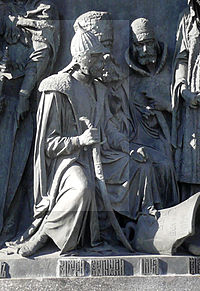
The Khanate of Kazan was a Tatar state that occupied the territory of the former Volga Bulgaria between 1438 and 1552. The khanate covered contemporary Tatarstan, Mari El, Chuvashia, Mordovia, and parts of Udmurtia and Bashkortostan; its capital was the city of Kazan. It was one of the successor states of the Golden Horde (Mongol state), and it came to an end when it was conquered by the Tsardom of Russia.

The Great Stand on the Ugra River or the Standing on the Ugra River, also known as the Battle of the Ugra, was a standoff in 1480 on the banks of the Ugra River between the forces of Akhmat Khan of the Great Horde, and Grand Prince Ivan III of the Grand Duchy of Moscow.
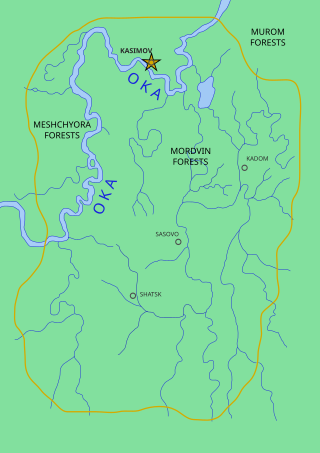
The Qasim Khanate was a Tatar-ruled khanate, a vassal of the Principality of Moscow, which existed from 1452 until 1681 in the territory of modern Ryazan Oblast in Russia with its capital at Kasimov, in the middle course of the Oka River. It was established in the lands which Grand Prince Vasily II of Moscow presented in 1452 to the Kazan prince Qasim Khan, son of the first Kazan khan Olug Moxammat.

The Battle of [the] Vedrosha was fought near the Vedrosha river, close to Dorogobuzh on 14 July 1500, during the Second Muscovite–Lithuanian War (1500–1503).
Xalil was Khan of the Kazan Khanate from 1466 to 1467, but very little is known about him. He was the eldest son of Khan Maxmud and grandson of the first Khan of Kazan, Ulugh Muhammad. He spent his life entirely in Kazan. He ascended to the throne after his father's death. He was succeeded by his brother Ibrahim.
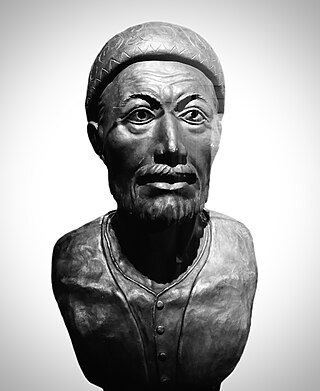
Möxämmät-Ämin xan (Volga Türki and Persian: محمد امین خان, Russian: Мухаммед-Амин, Магмед-Аминь, etc. was three times a pro-Russian khan of Kazan. During his first reign, he actively supported the policies of the Grand Duke of Moscow and proved himself to be "a true friend of Russia". He was also known as a poet; excerpts from his works have survived to this day. After ascending the throne for the second time, he changed his political views, emphasizing the independence of the khans. Muhammed-Amin "enjoyed the love and respect of the people"; Kazan flourished under him. Muhammed-Amin’s remains discovered in Soviet era were buried in the Kazan Kremlin in 2016.
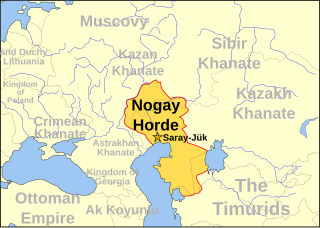
The Nogai Horde was a confederation founded by the Nogais that occupied the Pontic–Caspian steppe from about 1500 until they were pushed west by the Kalmyks and south by the Russians in the 17th century. The Mongol tribe called the Manghuds constituted a core of the Nogai Horde.

Mäxmüd Khan ; in Russian chronicles Махмутек (Makhmutek); died 1466) was the Khan of the Khanate of Kazan from 1445 to 1466.

The Great Horde was a rump state of the Golden Horde that existed from the mid-15th century to 1502. It was centered at the core of the former Golden Horde at Sarai on the lower Volga.
Ibrahim Khan was the Khan of Kazan from 1467. He was the son of Mäxmüd. He was crowned after Xälil's death and was married to Nur Sultan. In 1467–1469 and 1478, he participated in wars against Muscovy. After concluding a treaty with Ivan III, all Russian prisoners of war held by the Khanate were released. He supported a policy of non-intervention into Muscovy's politics.
The Russo-Crimean Wars were fought between the forces of the Tsardom of Russia and the Crimean Khanate during the 16th century over the region around the Volga River.

The Tokhtamysh–Timur war was fought from 1386 to 1395 between Tokhtamysh, the khan of the Golden Horde, and the warlord and conqueror Timur, founder of the Timurid Empire, in the areas of the Caucasus Mountains, Turkestan and Eastern Europe. The battle between Timur and Tokhtamysh played a key role in the decline of Mongol power over the Russian principalities.

The Russo-Kazan Wars were a series of short, intermittent wars fought between the Grand Principality of Moscow and the Khanate of Kazan between 1437 and 1556. Most of these were wars of succession in Kazan, in which Muscovy intervened on behalf of the dynastic interests of its main ally, the Crimean Khanate. For most of the period, neither side sought to conquer the other, until Ivan the Terrible decided to annex Kazan upon the successful 1552 siege, which was followed by a rebellion lasting until 1556.

The siege of Kazan or Fall of Kazan in 1552 was the final battle of the Russo-Kazan Wars and led to the fall of the Khanate of Kazan. Conflict continued after the fall of Kazan, however, as rebel governments formed in Çalım and Mişätamaq, and a new khan was invited from the Nogais. This guerrilla war lingered until 1556.

Daniil Dmitrievich Kholmsky was a Russian knyaz (князь), boyar and voyevoda (воевода), and one of the most prominent military leaders of Ivan the Great. He belonged to the princely house Kholmsky and was the father of another voyevoda and boyar, Vasily Danilovich Kholmsky, who later married the second daughter of Ivan the Great, Feodosiya Ivanovna.

Ulugh Muhammad or Muhammad Khan was a medieval Tatar statesman, Gengisid, Khan of the Golden Horde, ruler of Crimea (1437), and the founder of the Khanate of Kazan, which he ruled from 1438–1445. He was the son of the oglan Ichkile Hassan and the cousin of Tokhtamysh. He received the nickname "Ulugh", meaning older or large, in contrast to Küchük Muhammad, meaning younger or small.

The Battle of Mstislavl took place on 4 November 1501 between the forces of the Grand Duchy of Lithuania and the forces of the Grand Duchy of Moscow and Principality of Novgorod-Seversk. The Lithuanian forces were defeated.
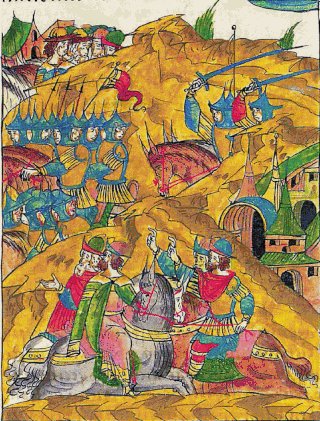
The Battle of Belyov was fought in 1437 near Belyov between the troops of the Grand Duchy of Moscow under the command of Dmitry Shemyaka and Tatars led by Ulugh Muhammad. The result of the battle is interpreted completely differently in different sources.

The Expedition to Vyborg was a major military campaign undertaken by the Russians, took place in winter of 1556. The main goal of the expedition was to inflict as much material and human damage as possible, which would force Stockholm to request a truce.





